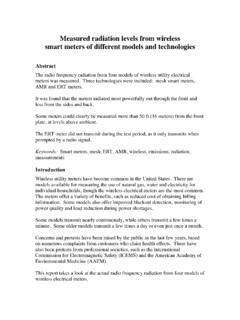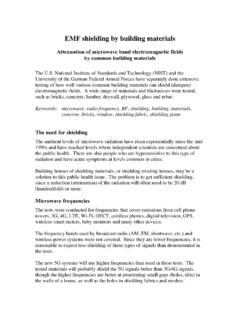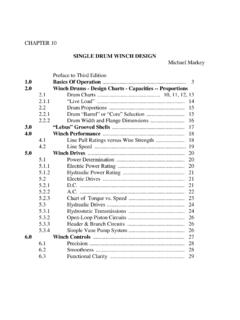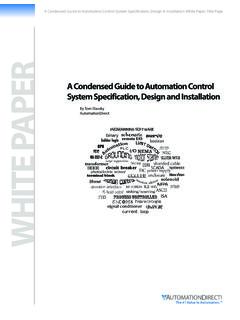Transcription of The Smart Meters: What are the different types, how do ...
1 The Smart meters : What are the different types, how do they work and what are the health issues? The mechanical meters for electricity, gas and water are being replaced with new digital meters in much of the industrialized world. The more advanced models are called Smart meters , while the simple models are called AMR meters . They are all causing health concerns, especially among those who are electro hypersensitive (EHS). This article describes the different types of meters , what the problems with them are and why the utilities promote them. Executive Summary There are several types of electronic meters available. Some are read monthly, while others transmit data every few seconds. The concerns are both about the meters which transmit using wireless and those which transmit across the electrical wires in the house and neighborhood.
2 The wireless method can be similar to having a wireless network in the house or a cell phone which is in constant use, but not against the head. This is fine for some, while others cannot live with it. The meters transmitting via the electrical wires produce dirty electricity , which turns all the household wiring throughout the neighborhood into unintentional antennas. It may also radiate up into a house from stray currents running in the soil. The wireless transmitters have stronger signals, but transmit only from a few places. The power line communication system emits weaker signals but is everywhere, and is harder to mitigate. All digital meters have electronics inside. On some models, electronic components create powerful dirty electricity which has been a problem for the resident. The trend is to transmit more often than in the recent past, where many systems only transmitted once a month or once a day.
3 2 The new Smart meters Many of the meters being installed today can later be programmed to transmit more frequently and perform more functions. Some models are modular, with the ability to swap out the transmitter with a later model or a different type. The different technologies available offer trade-offs between what features are currently wanted by the utility and what the impacts are on the public health. Table of Contents 1. Introduction 2. Why are these meters being installed? The new meters are cheaper to read They can encourage customers to save energy The utility gets better information The utility can better manage consumption Faster to recover from a black-out Faster locating line breaks Easy connect/disconnect of service The new meters can be more accurate 3. The different types of meters Mechanical meters Simple digital meters Upgraded mechanical meters Remotely read meters Smart meters Pre-pay meters Gas and water meters 4.
4 The communication technologies Telephone dialup Fiber optic cable Cellular communication Radio communication Fixed wireless network SUNDS Mesh network The new Smart meters 3 Power line communication Low-frequency PLC Medium-frequency PLC Broadband PLC Home Area Network 5. The radiation from the meters The switched-mode power supply The internal computer circuits The wireless receiver The wireless transmitter Dirty electricity on the household wires Dirty electricity in the ground currents 6. Health issues 7. The most problematic technologies 8. For more information 4 The new Smart meters 1. Introduction This article is concerned only with the health issues with the new meters . The other areas of concern, such as privacy, pirating and ethical/accurate billing are not addressed.
5 When contacting the utilities and public officials, it is essential to be well-informed to be taken seriously. This document provides the foundation for communicating effectively with the authorities. Some readers may think the author is promoting Smart meters when they read the first part of this article. That is not the case, the author only recognizes that there are some benefits to them, and wishes to provide an accurate, balanced picture of the issues. There are problems enough, understanding them is easier when knowing what the meters are used for, which is described in the following. The current big push is to replace the electrical meters . The replacement of meters for gas and water is happening much slower as there is currently no government interest in doing so. This article focuses on the electrical meters , though much of the information also applies to digital gas and water meters .
6 2. Why are these meters being installed? The government has given large grants to utilities to install Smart meters . In some countries, such as Sweden, the government has essentially mandated they be installed. In many cases, the utility companies are also interested on their own, though the investment cost has slowed them down. The reasons for installing these meters may be: they are much cheaper to read they allow the electricity to be cheaper at off hours they encourage using less electricity they encourage shifting usage to off-peak hours they are more accurate (when working correctly) the utilities have better usage information they allow the utility to better manage the grid they allow more solar and wind power to be used The new Smart meters 5 they help locate line breaks disconnect/reconnect of service is much simpler Not all meters have all these functions.
7 It is up to the utility which will be available. The following sections describe what the meters do in terms of these reasons. Later, we ll look more closely at how they communicate, which is the main concern of this paper. The new meters are cheaper to read There is a large cost savings in no longer needing employees to visit each meter once a month. With the old meters , a meter reader comes by once a month and reads off the number. In many cases, this is done from a car, where the meter s dial is photographed using a camera with a tele-lens. The digital photo is then inspected at a central location, by a person who enters the number into a computer. In some areas, the meter reader must walk to each meter, which takes a lot of staff time. In older houses in Europe and the eastern United States, the meters are located inside people s houses, making reading them manually very time consuming.
8 The new meters require much less staff. One type is read from a car that drives through the neighborhood without stopping. One manufacturer boasts that a single person can read off 100,000 meters in a day with this method. Other types of meters communicate directly with the utility home office, without any meter readers at all. One rural utility serving 20,000 households has stated they could eliminate their three meter reading jobs at a savings of $65,000 a year (one meter reader was retiring, the two others would be given other duties). Customer education for energy savings Some utilities have a web site where customers can see how their consumption of electricity changes by the hour sometimes even by the minute. The idea is that customers will be able to see how cranking up the air conditioner in the afternoon affects their monthly bill.
9 How deferring running the clothes dryer to off-hours might save them money. 6 The new Smart meters This may get people to use less electricity during the peak hours, where the utilities have to use expensive power plants to cover the peak electrical usage. It can save the utility money if the usage of electricity is more even across the day. Utilities typically offer this information a day later, as they receive the data during a nightly download from the Smart meter. More sophisticated Smart meter networks, which communicate very frequently, may offer the customer the information in nearly real-time. Another educational tool is a wall display, which shows the consumption of electricity in real-time, as well as how much has been used that day. The wall display gets the information directly from the Smart meter mounted on the house.
10 The utility gets better information Managing an electrical grid is like walking a tightrope. The grid must be in perfect balance at all times between what the consumers use and what the power plants produce. When they fail, we have brownouts where the voltage gets too low, which can damage household electronics and appliances. Or we may see total blackouts. This balancing act will become more complicated in the future when there will be more power coming from wind turbines, solar power plants and other sources. Having more detailed information about how electricity is consumed helps with these balancing acts. Some models of the meters monitor the line voltage and report it to the utility. This information can be used to decide where to upgrade or reconfigure their distribution lines, which means more reliable and better service to their customers.













